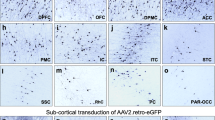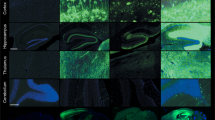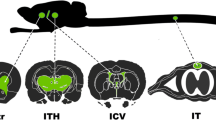Abstract
A pilot study in nonhuman primates was conducted, in which two Rhesus macaques received bilateral parenchymal infusions of adeno-associated virus serotype 9 encoding green fluorescent protein (AAV9-GFP) into each putamen. The post-surgical in-life was restricted to 3 weeks in order to minimize immunotoxicity expected to arise from expression of GFP in antigen-presenting cells. Three main findings emerged from this work. First, the volume over which AAV9 expression was distributed (Ve) was substantially greater than the volume of distribution of MRI signal (Vd). This stands in contrast with Ve/Vd ratio of rAAV2, which is lower under similar conditions. Second, post-mortem analysis revealed expression of GFP in thalamic and cortical neurons as well as dopaminergic neurons projecting from substantia nigra pars compacta, indicating retrograde transport of AAV9. However, fibers in the substantia nigra pars reticulata, a region that receives projections from putamen, also stained for GFP, indicating anterograde transport of AAV9 as well. Finally, one hemisphere received a 10-fold lower dose of vector compared with the contralateral hemisphere (1.5 × 1013 vg ml−1) and we observed a much stronger dose effect on anterograde-linked than on retrograde-linked structures. These data suggest that AAV9 can be axonally transported bi-directionally in the primate brain. This has obvious implications to the clinical developing of therapies for neurological disorders like Huntington’s or Alzheimer’s diseases.
This is a preview of subscription content, access via your institution
Access options
Subscribe to this journal
Receive 12 print issues and online access
$259.00 per year
only $21.58 per issue
Buy this article
- Purchase on Springer Link
- Instant access to full article PDF
Prices may be subject to local taxes which are calculated during checkout




Similar content being viewed by others
References
Fiandaca MS, Varenika V, Eberling J, McKnight T, Bringas J, Pivirotto P et al. Real-time MR imaging of adeno-associated viral vector delivery to the primate brain. Neuroimage 2009; 47 (Suppl 2): T27–T35.
Richardson RM, Kells AP, Rosenbluth KH, Salegio EA, Fiandaca MS, Larson PS et al. Interventional MRI-guided putaminal delivery of AAV2-GDNF for a planned clinical trial in Parkinson's disease. Mol Ther 2011; 19: 1048–1057.
Ciesielska A, Mittermeyer G, Hadaczek P, Kells AP, Forsayeth J, Bankiewicz KS . Anterograde axonal transport of AAV2-GDNF in rat basal ganglia. Mol Ther 2011; 19: 922–927.
Kells AP, Forsayeth J, Bankiewicz KS . Glial-derived neurotrophic factor gene transfer for Parkinson's disease: anterograde distribution of AAV2 vectors in the primate brain. Neurobiol Dis 2012; 48: 228–235.
Salegio EA, Samaranch L, Kells AP, Mittermeyer G, San Sebastian W, Zhou S et al. Axonal transport of adeno-associated viral vectors is serotype-dependent. Gene Ther 2012; 20: 348–352.
San Sebastian W, Samaranch L, Heller G, Kells AP, Bringas J, Pivirotto P et al. Adeno-associated virus type 6 is retrogradely transported in the non-human primate brain. Gene Ther 2013; 20: 1178–1183.
Ciesielska A, Hadaczek P, Mittermeyer G, Zhou S, Wright JF, Bankiewicz KS et al. Cerebral infusion of AAV9 vector-encoding non-self proteins can elicit cell-mediated immune responses. Mol Ther 2013; 21: 158–166.
Samaranch L, San Sebastian W, Kells AP, Salegio EA, Heller G, Bringas JR et al. AAV9-mediated expression of a non-self protein in nonhuman primate central nervous system triggers widespread neuroinflammation driven by antigen-presenting cell transduction. Mol Ther 2014; 22: 329–337.
Richardson RM, Kells AP, Martin AJ, Larson PS, Starr PA, Piferi PG et al. Novel platform for MRI-guided convection-enhanced delivery of therapeutics: preclinical validation in nonhuman primate brain. Stereotact Funct Neurosurg 2011; 89: 141–151.
Cornet A, Bettelli E, Oukka M, Cambouris C, Avellana-Adalid V, Kosmatopoulos K et al. Role of astrocytes in antigen presentation and naive T-cell activation. J Neuroimmunol 2000; 106: 69–77.
Nelson PT, Soma LA, Lavi E . Microglia in diseases of the central nervous system. Ann Med 2002; 34: 491–500.
Kells AP, Hadaczek P, Yin D, Bringas J, Varenika V, Forsayeth J et al. Efficient gene therapy-based method for the delivery of therapeutics to primate cortex. Proc Natl Acad Sci USA 2009; 106: 2407–2411.
San Sebastian W, Kells AP, Bringas J, Samaranch L, Hadaczek P, Ciesielska A et al. Safety and tolerability of mri-guided infusion of aav2-haadc into the mid-brain of non-human primate. Mol Ther Methods Clin Dev 2014; 3: 14049.
Hadaczek P, Yamashita Y, Mirek H, Tamas L, Bohn MC, Noble C et al. The "perivascular pump" driven by arterial pulsation is a powerful mechanism for the distribution of therapeutic molecules within the brain. Mol Ther 2006; 14: 69–78.
Summerford C, Samulski RJ . Membrane-associated heparan sulfate proteoglycan is a receptor for adeno-associated virus type 2 virions. J Virol 1998; 72: 1438–1445.
Shen S, Bryant KD, Brown SM, Randell SH, Asokan A . Terminal N-linked galactose is the primary receptor for adeno-associated virus 9. J Biol Chem 2011; 286: 13532–13540.
Gray SJ, Matagne V, Bachaboina L, Yadav S, Ojeda SR, Samulski RJ . Preclinical differences of intravascular AAV9 delivery to neurons and glia: a comparative study of adult mice and nonhuman primates. Mol Ther 2011; 19: 1058–1069.
Hinderer C, Bell P, Vite CH, Louboutin J-P, Grant R, Bote E et al. Widespread gene transfer in the central nervous system of cynomolgus macaques following delivery of AAV9 into the cisterna magna. Mol Ther Methods Clin Dev 2014; 1: 14051.
Foust KD, Nurre E, Montgomery CL, Hernandez A, Chan CM, Kaspar BK . Intravascular AAV9 preferentially targets neonatal neurons and adult astrocytes. Nat Biotechnol 2009; 27: 59–65.
Forsayeth J, Bankiewicz KS . Transduction of antigen-presenting cells in the brain by AAV9 warrants caution in preclinical studies. Mol Ther 2015; 23: 612.
Costantini LC, Jacoby DR, Wang S, Fraefel C, Breakefield XO, Isacson O . Gene transfer to the nigrostriatal system by hybrid herpes simplex virus/adeno-associated virus amplicon vectors. Hum Gene Ther 1999; 10: 2481–2494.
Diefenbach RJ, Miranda-Saksena M, Douglas MW, Cunningham AL . Transport and egress of herpes simplex virus in neurons. Rev Med Virol 2008; 18: 35–51.
Lilley CE, Groutsi F, Han Z, Palmer JA, Anderson PN, Latchman DS et al. Multiple immediate-early gene-deficient herpes simplex virus vectors allowing efficient gene delivery to neurons in culture and widespread gene delivery to the central nervous system in vivo. J Virol 2001; 75: 4343–4356.
McGraw HM, Friedman HM . Herpes simplex virus type 1 glycoprotein E mediates retrograde spread from epithelial cells to neurites. J Virol 2009; 83: 4791–4799.
Gillet JP, Derer P, Tsiang H . Axonal transport of rabies virus in the central nervous system of the rat. J Neuropathol Exp Neurol 1986; 45: 619–634.
Kelly RM, Strick PL . Rabies as a transneuronal tracer of circuits in the central nervous system. J Neurosci Methods 2000; 103: 63–71.
Klingen Y, Conzelmann KK, Finke S . Double-labeled rabies virus: live tracking of enveloped virus transport. J Virol 2008; 82: 237–245.
Larsen DD, Wickersham IR, Callaway EM . Retrograde tracing with recombinant rabies virus reveals correlations between projection targets and dendritic architecture in layer 5 of mouse barrel cortex. Front Neural Circuits 2007; 1: 5.
Kaspar BK, Llado J, Sherkat N, Rothstein JD, Gage FH . Retrograde viral delivery of IGF-1 prolongs survival in a mouse ALS model. Science 2003; 301: 839–842.
Berardelli A, Noth J, Thompson PD, Bollen EL, Curra A, Deuschl G et al. Pathophysiology of chorea and bradykinesia in Huntington's disease. Mov Disord 1999; 14: 398–403.
Matsushita T, Elliger S, Elliger C, Podsakoff G, Villarreal L, Kurtzman GJ et al. Adeno-associated virus vectors can be efficiently produced without helper virus. Gene Ther 1998; 5: 938–945.
Krauze MT, Saito R, Noble C, Tamas M, Bringas J, Park JW et al. Reflux-free cannula for convection-enhanced high-speed delivery of therapeutic agents. J Neurosurg 2005; 103: 923–929.
Fiandaca MS, Forsayeth JR, Dickinson PJ, Bankiewicz KS . Image-guided convection-enhanced delivery platform in the treatment of neurological diseases. Neurotherapeutics 2008; 5: 123–127.
Acknowledgements
This study was funded by Sangamo Inc. (Point Richmond, CA, USA) and by an NIH-NINDS grant to KSB (R01NS073940-01).
Author information
Authors and Affiliations
Corresponding author
Ethics declarations
Competing interests
The authors declare no conflict of interest.
Additional information
Supplementary Information accompanies this paper on Gene Therapy website
Supplementary information
Rights and permissions
About this article
Cite this article
Green, F., Samaranch, L., Zhang, H. et al. Axonal transport of AAV9 in nonhuman primate brain. Gene Ther 23, 520–526 (2016). https://doi.org/10.1038/gt.2016.24
Received:
Revised:
Accepted:
Published:
Issue Date:
DOI: https://doi.org/10.1038/gt.2016.24
This article is cited by
-
Improving Gene Therapy for Angelman Syndrome with Secreted Human UBE3A
Neurotherapeutics (2022)
-
A direct interareal feedback-to-feedforward circuit in primate visual cortex
Nature Communications (2021)
-
Gene Therapy for Neurodegenerative Diseases
Neurotherapeutics (2019)
-
Emerging Technologies for Delivery of Biotherapeutics and Gene Therapy Across the Blood–Brain Barrier
BioDrugs (2018)
-
MR-guided parenchymal delivery of adeno-associated viral vector serotype 5 in non-human primate brain
Gene Therapy (2017)



